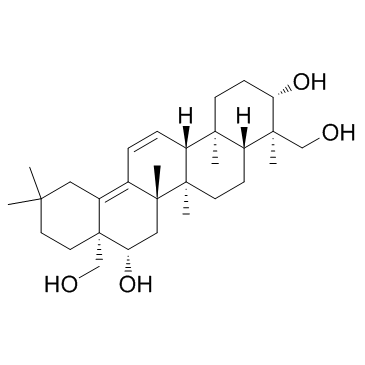5092-09-1
| Name | (3S,4R,4aR,6aR,6bS,8S,8aS,14aS,14bS)-4,8a-bis(hydroxymethyl)-4,6a,6b,11,11,14b-hexamethyl-1,2,3,4a,5,6,7,8,9,10,12,14a-dodecahydropicene-3,8-diol |
|---|---|
| Synonyms |
Oleana-11,13(18)-diene-3,16,23,28-tetrol, (3β,16β)-
(3β,4α,16β)-Oleana-11,13(18)-diene-3,16,23,28-tetrol saikogenin A (3β,16β)-Oleana-11,13(18)-diene-3,16,23,28-tetrol |
| Description | Saikogenin A, extracted from a Chinese herbal plant called Tsai-Fu, is a dipeptidyl peptidase-IV (DPP-IV) inhibitor. |
|---|---|
| Related Catalog | |
| Target |
DPP-IV[1] |
| In Vitro | Saikogenin A has certain inhibitory effect on the enzyme DPP-IV. At a concentration of 20 μg/mL DPP-IV inhibition is 47.6%. DPP-IV is a non-classical serine aminopeptidase from its amino terminus of polypeptides and proteins (N-terminus) removing Xaa-Pro dipeptide[1]. |
| In Vivo | Saikogenin A, an anti-inflammatory drug, is present in the crude extract of a Chinese herbal plant called Tsai-Fu. Saikogenin A is less effective in adrenalectomized rats than in normal rats in reducing the carrageenin-induced edema. The anti-inflammatory action of Saikogenin A are due to an increase in corticosterone caused by the release of arenocorticotropic hormone (ACTH) and a direct effect on the process of inflammation[2]. |
| References |
[1]. Pharmaceutical application of saikogenin A. CN107375300A. |
| Density | 1.2±0.1 g/cm3 |
|---|---|
| Boiling Point | 607.4±55.0 °C at 760 mmHg |
| Molecular Formula | C30H48O4 |
| Molecular Weight | 472.700 |
| Flash Point | 252.4±26.1 °C |
| Exact Mass | 472.355255 |
| PSA | 80.92000 |
| LogP | 5.38 |
| Vapour Pressure | 0.0±3.9 mmHg at 25°C |
| Index of Refraction | 1.586 |
